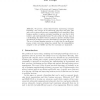96 search results - page 2 / 20 » The role of secondary attributes in formal object modelling |
ICFCA
2010
Springer
13 years 11 months ago
2010
Springer
Abstract. In the past years Software Engineering has experienced several difficulties in modularising crosscutting aspects, like shared, dynamic or scattered behavior of object-ori...
BMCBI
2005
13 years 4 months ago
2005
Background: Alignment of RNA secondary structures is important in studying functional RNA motifs. In recent years, much progress has been made in RNA motif finding and structure a...
ECSCW
1997
13 years 6 months ago
1997
: Formal tools (i.e , tools that operate on circumscribed input using rules, and that contain a model of the workplace in which are to function) are attributed central roles in org...
DLOG
2007
13 years 7 months ago
2007
Object-Role modellers miss the advantages of automated reasoning over their ORM conceptual models, which could be addressed by DL reasoners. DLs are not considered user-friendly an...
CAISE
2000
Springer
13 years 9 months ago
2000
Springer
We present a formal framework for representing enterprise knowledge. The concepts of our framework (objectives and goals, roles and actors, actions and processes, responsibilities ...

